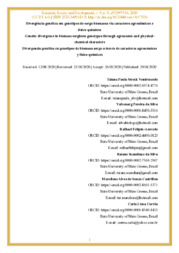Genetic divergence in biomass sorghum genotypes through agronomic and physicalchemical characters.
Genetic divergence in biomass sorghum genotypes through agronomic and physicalchemical characters.
Autoria: VENDRUSCOLO, T. P. S.; SILVA, V. P. da; FELIPIN-AZEVEDO, R.; SILVA, R. S. da; CASTRILLON, M. A. de S.; CORRÊA, C. L.; TARDIN, F. D.; BARELLI, M. A. A.
Resumo: The present research aimed to evaluate the genetic divergence in 34 sorghum biomass genotypes via agronomic and physicochemical characters. The design used was randomized blocks with three replications. The agronomic and physical-chemical characteristics evaluated were: days for flowering, number of stems, plant height, number of leaves, green mass production, dry mass production, determination of total ash, determination of volatile content, insoluble lignin and determination of fixed carbon content. The data were submitted to analysis of variance and then, to estimate divergence,the generalized Mahalanobisdistance was used as a measure of dissimilarity. Based on this matrix, the methods of Tocher's optimization clusters and the Hierarchical method of Average Grouping Between Groups (UPGMA) were used, and analysis of canonical variables, and the projection based on the first two canonical variables arranged in two-dimensional space. Singh criterion was also used to quantify the relative contribution of these characteristics to genetic divergence. The evaluated genotypes showed significant differences for all the evaluated characteristics. The combination between the 201429B001 and 201429B028 (394.98) genotype pairs was the most divergent and the combination between the 201429B015 and 201429B031 (6.31) genotypes was the most similar. The grouping generated by the Tocher Optimization method, hierarchical UPGMA and graphical dispersion showed similarity in the grouping of genotypes. The first two canonical variables were sufficient to explain about 81.78% of the total variation observed. Theresults showed a wide genetic diversity among the 34 genotypes of sorghum biomass.
Ano de publicação: 2020
Tipo de publicação: Artigo de periódico
Unidade: Embrapa Milho e Sorgo
Palavras-chave: Análise multivariada, Melhoramento Genético Vegetal, Sorghum Bicolor
Observações
1 - Por padrão são exibidas publicações dos últimos 20 anos. Para encontrar publicações mais antigas, configure o filtro ano de publicação, colocando o ano a partir do qual você deseja encontrar publicações. O filtro está na coluna da esquerda na busca acima.
2 - Para ler algumas publicações da Embrapa (apenas as que estão em formato ePub), é necessário ter, no celular ou computador, um desses softwares gratuitos. Sistemas Android: Google Play Livros; IOS: iBooks; Windows e Linux: software Calibre.
Acesse outras publicações
Acesse a Base de Dados da Pesquisa Agropecuária (BDPA) para consultar o acervo completo das bibliotecas da Embrapa.

